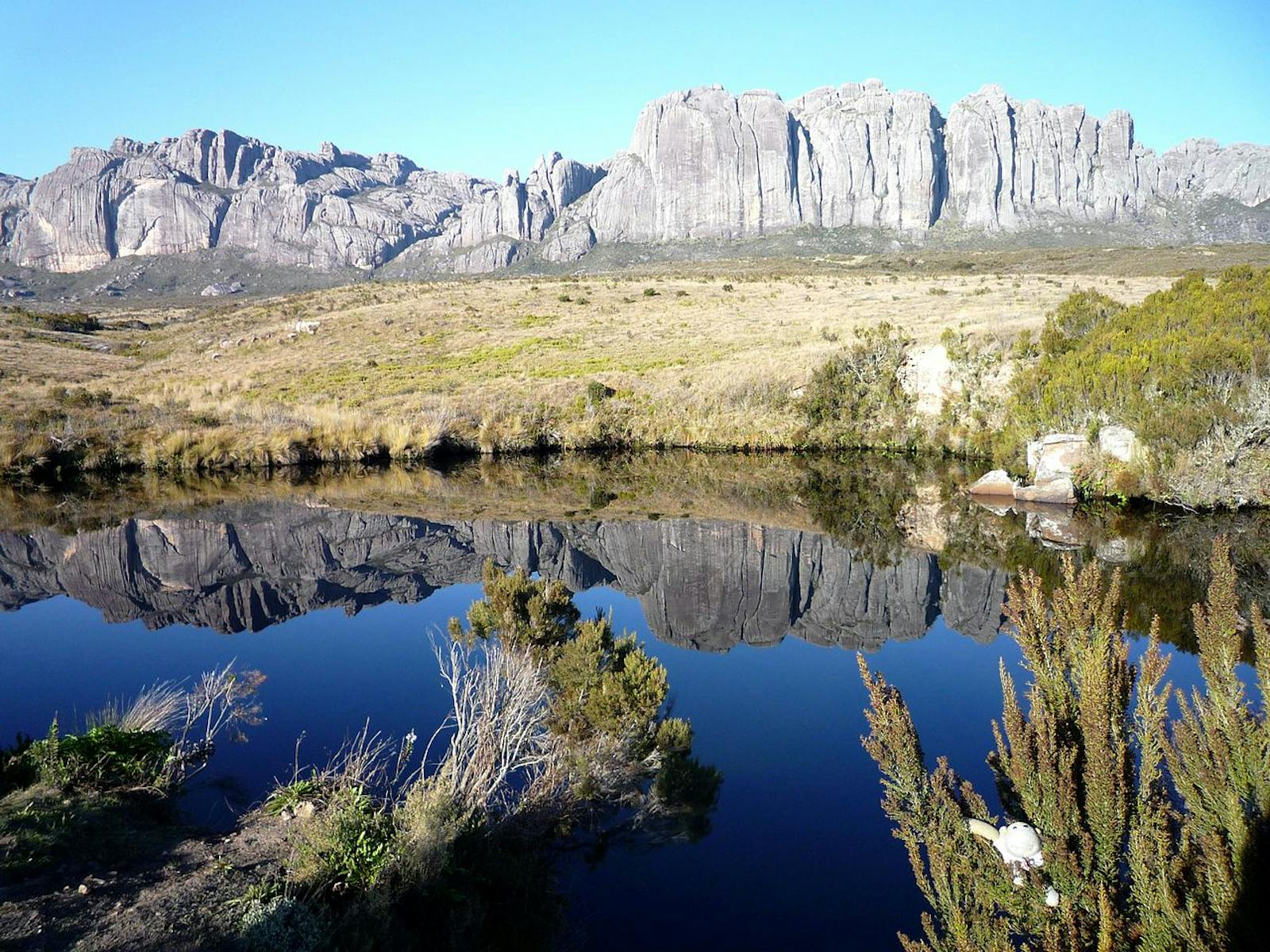Madagascar Ericoid Thickets
The ecoregion’s land area is provided in units of 1,000 hectares. The conservation target is the Global Safety Net (GSN1) area for the given ecoregion. The protection level indicates the percentage of the GSN goal that is currently protected on a scale of 0-10. N/A means data is not available at this time.
Bioregion: Madagascar Island (AT6)
Realm: Afrotropics
Ecoregion Size (1000 ha):
128
Ecoregion ID:
83
Conservation Target:
72%
Protection Level:
2
States: Madagascar
Ericoid thickets are one of the most vulnerable habitats in Madagascar to a changing climate. The thickets are physically constrained to the upper elevations of the four major massifs in the country, therefore they cannot shift upwards to adapt to warming temperatures. As a result, the sharpest declines in biodiversity in Madagascar are predicted here, as well as species range contractions and extinctions.
The ecoregion includes the ericoid thicket habitats found above approximately 1,800 m on the upper slopes of Madagascar’s four major massifs: Tsaratanana (2,876 m), Marojejy (2,133 m), Ankaratra (2,643 m), and Andringitra (2,658 m). On Tsaratanana, montane sclerophyllous forest exists up to about 2,500 m and then changes to ericoid thicket, while on these other three massifs the transition to ericoid thicket commences just below 2,000 m. There is considerable daily and seasonal fluctuation in the temperature of these montane areas. Snow has been recorded on the Andringitra Massif during the cold season, and the temperature can fall as low as -11°C. The maximum daily temperatures can reach over 30°C.
Rainfall is more than 2,500 mm per year on the wetter eastward facing slopes of these massifs. The great temperature range and intense sunlight can lead to temporary arid conditions. Small, damp, and peat-filled depressions harbor specialized, endemic plants, while rock outcrops host a drought-tolerant flora including Aloe, Kalanchoe,and Helichrysum. Plants that grow on rock outcrops are less threatened than other ericoid thicket species because the rocky areas block the local passage of fire. Highland areas are important sources of water for domestic and agricultural uses.
On the major mountain massifs of Madagascar, species richness of numerous groups, such as birds, reptiles, and amphibians, decreases with altitude, while other taxa such as rodents and insectivores show distinct mid-elevational bulges. The flora is notable for containing a number of endemic species and elements linked to other biogeographical regions.
While endemism on these mountains is very high at the species level, they often belong to widespread genera. For example, the true heathers in the genus Erica are also represented in the Mascarenes and mainland Africa, but have undergone extensive speciation in Madagascar.
Two mammals are considered endemic to this ecoregion or the ecotone between it and the upper limit of the Madagascar Subhumid Forest ecoregion. Both have been described as new genera: Malagasy mountain mouse, known from the massifs of Ankaratra, Andringitra, and Andohahela, and Northern voalavo, endemic to the Marojejy-Anjanaharibe-Sud Massifs.
The characteristic bird fauna of these high mountains includes several species narrowly limited to this habitat, such as cryptic warbler and yellow-bellied sunbird-asity. The thicket supports endemic reptiles including the geckos, Millotisaurus mirabilis, and Arnoult’s Dwarf Gecko.
Highland ecosystems have disappeared or are highly degraded due to pressure from livestock grazing and agriculture expansion. Three of the four most important montane areas represented in this ecoregion are included in protected areas: Tsaratanana strict nature reserve, Andringitra National Park, and Marojejy National Park. The Corridor Marojejy Tsaratanana creates a protective corridor between Tsaratanana and Marojejy. The Andringitra and Marojejy Massifs have the best-preserved habitats. The high elevation patches are naturally fragmented due to the dispersed location of the mountain ranges throughout Madagascar.
The major threat is conversion to highland cattle pasture, as has already occurred on the Plateau d’Andohariana on the Andringitra Massif. Associated with these pasturelands are regular burns to stimulate young grass growth, particularly on the drier western slopes of the mountains. This ecoregion is buffered, to some extent, by the surrounding forests of lower altitudes.
However, these forests are also experiencing increasing pressure from expansion of domestic animal rangelands. In Tsaratanana and Ankaratra, frequent burning has degraded significant areas of the montane habitat, although fires from lightning strikes may have always been part of the natural cycle in this region, as indicated by the presence of high densities of fire-dependent plants such as members of the Asteraceae and Ericaceae. Domestic animals may also disperse, through their faeces, the seeds of introduced plants into ericoid thickets.
The priority conservation actions for the next decade will be to: 1) strengthen the technical capacity of local communities in relation to agriculture, and encourage new environmentally friendly farming techniques; 2) establish invasive alien species eradication measures; and 3) strengthen programs to control bush fires.
Citations
1. Burgess, N., Hales, J.A., Underwood, E., Dinerstein, E., Olson, D., Itoua, I., Schipper, J., Ricketts, T. and Newman, K. 2004. Terrestrial ecoregions of Africa and Madagascar: a conservation assessment. Island Press.
2. Brown, K.A., Parks, K.E., Bethell, C.A., Johnson, S.E. and Mulligan, M. 2015. Predicting plant diversity patterns in Madagascar: understanding the effects of climate and land cover change in a biodiversity hotspot. PloS one. 10(4), p.e0122721.
3. CEPF. 2014. Ecosystem profile: Madagascar and Indian Ocean Islands. [Online]. [Accessed 16 March 2018]. Available from: https://www.cepf.net/sites/default/files/ecosystemprofile_madagascar_en.pdf
4. Government of Madagascar. 2015. National Biodiversity and Action Plans 2015-2025. Madagascar: Ministry of the environment, ecology, the sea and forestry.




